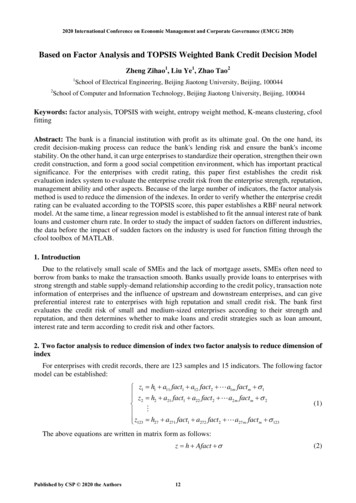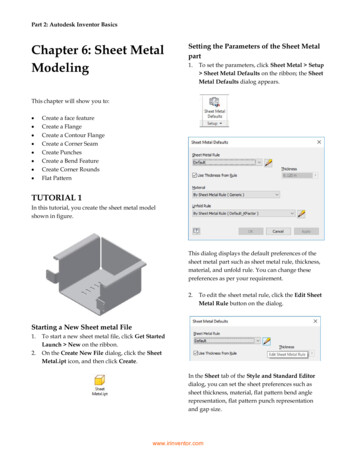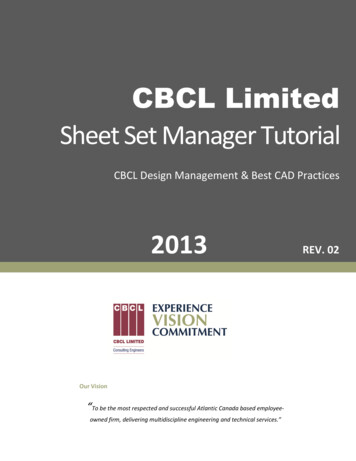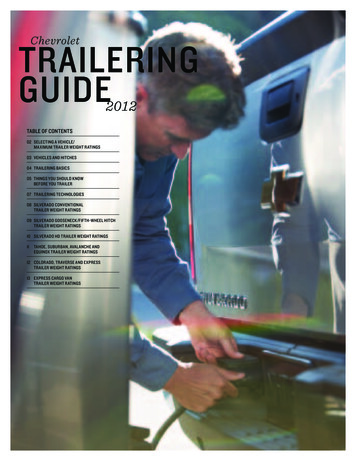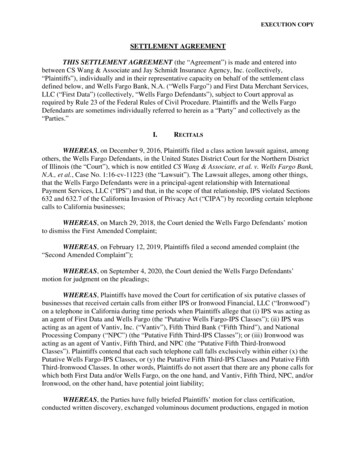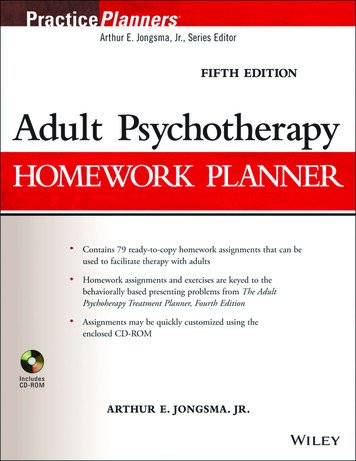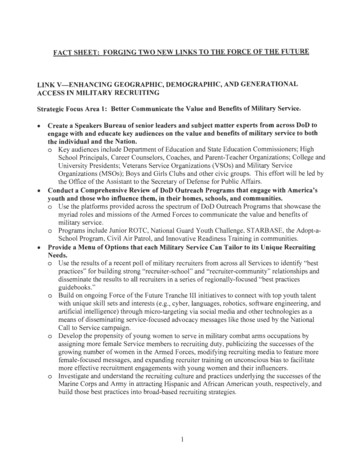
Transcription
FACT SHEET: FORGING TWO NEW LINKS TO THE FORCE OF THE FUTURELINK V-ENHANCING GEOGRAPHIC, DEMOGRAPHIC, AND GENERATIONALACCESS IN MILITARY RECRUITINGStrategic Focus Area 1: Better Communicate the Value and Benefits of Military Service. Create a Speakers Bureau of senior leaders and subject matter experts from across DoD toengage with and educate key audiences on the value and benefits of military service to boththe individual and the Nation.o Key audiences include Department of Education and State Education Commissioners; HighSchool Principals, Career Counselors, Coaches, and Parent-Teacher Organizations; College andUniversity Presidents; Veterans Service Organizations (VSOs) and Military ServiceOrganizations (MSOs); Boys and Girls Clubs and other civic groups. This effort will be led bythe Office of the Assistant to the Secretary of Defense for Public Affairs.Conduct a Comprehensive Review of DoD Outreach Programs that engage with America'syouth and those who influence them, in their homes, schools, and communities.o Use the platforms provided across the spectrum of DoD Outreach Programs that showcase themyriad roles and missions of the Armed Forces to communicate the value and benefits ofmilitary service.o Programs include Junior ROTC, National Guard Youth Challenge, STARBASE, the Adopt-aSchool Program, Civil Air Patrol, and Innovative Readiness Training in communities.Provide a Menu of Options that each Military Service Can Tailor to its Unique RecruitingNeeds.o Use the results of a recent poll of military recruiters from across all Services to identify "bestpractices" for building strong "recruiter-school" and "recruiter-community" relationships anddisseminate the results to all recruiters in a series ofregionally-focused "best practicesguidebooks."o Build on ongoing Force of the Future Tranche III initiatives to connect with top youth talentwith unique skill sets and interests (e.g. , cyber, languages, robotics, software engineering, andartificial intelligence) through micro-targeting via social media and other technologies as ameans of disseminating service-focused advocacy messages like those used by the NationalCall to Service campaign.o Develop the propensity of young women to serve in military combat arms occupations byassigning more female Service members to recruiting duty, publicizing the successes of thegrowing number of women in the Armed Forces, modifying recruiting media to feature morefemale-focused messages, and expanding recruiter training on unconscious bias to facilitatemore effective recruitment engagements with young women and their influencers.o Investigate and understand the recruiting culture and practices underlying the successes of theMarine Corps and Army in attracting Hispanic and African American youth, respectively, andbuild those best practices into broad-based recruiting strategies.1
Strategic Focus Area 2: Build and Solidify the "DoD Brand". Fund the DoD Joint Advertising Marketing Research & Studies (JAMRS) program to:o Develop and execute a sustained advertising and marketing campaign using customized contentdisseminated through separate, but integrated print, TV, digital, and social media informationand messaging by employing the Precision Recruiting Database, a Force of the Future TrancheIII initiative, to create a more robust recruiting database that leverages predictive analytics andmicro-targeting to improve access to, and propensity among, America' s youth and theirinfluencers-at both national and regional levels.o Aim the campaign at connecting with and educating potential applicants, their influencers, andother members of the public about the value and benefits of military service; buildingrecognition of the DoD brand; and growing a propensity to serve.o Synchronize JAMRS efforts with Military Service recruiting campaigns.- The primary objective of the DoD campaign is not to "recruit" (that is the Services' role)but to generate greater awareness of the value and benefits of military service and to engageeffectively with youth and their influencers to create a more informed and receptiveenvironment for the Services' recruiting efforts.Strategic Focus Area 3: OSD Support to Military Service Recruiting Efforts. Enhance military recruiter access to high school students.o In cases in which access does not comport with the law, initiate engagements with appropriatefederal, state, and local officials to educate them about legal requirements and resolve instancesof non-compliance (as required by Title 10, U. S. Code, section 503).o Identify the types of access that are most beneficial (additive to the minimum access requiredby law), using the results of a recent poll of military recruiters from across all Services, whichwill be available in January 2017. Include information about access opportunities in theregionally-focused "best practices guidebooks" for recruiters.Expand partnerships between the Armed Forces YMCAs and Boys and Girls Clubs and themilitary.o Pilot a program to provide recruiters with free "swim lesson" vouchers to distribute toapplicants-particularly those in the Delayed Entry Program- who have never learned to swimor are not strong swimmers.Provide a Menu of Options that each Military Service Can Tailor to its Unique RecruitingNeeds.o Glean lessons learned from the nascent Air Force pilot in the Northeast United States and theNavy pilot in the Midsouth.- Leverage predictive models to identify both "priority qualified" applicants- those mostlikely to be successful in military training and service, as well as potential applicants whoare "undecided".- Develop a "shared leads" database to facilitate the transfer of recruitment leads acrossprogram silos (e.g., forwarding a college-bound lead who may be well-qualified andpropensed for military service to a recruiter focused on Military Service Academy andROTC Scholarship programs).2
oPilot streamlined processes for the acquisition of technology-oriented recruiting tools.- Enable the rapid fielding of portable, cutting-edge technology with which to engage ITsavvy youth (e.g. , smartphones, tablets, live chat, avatars, games), increasing virtualrecruiting capabilities and affording applicants "real world" military training and serviceexperiences.o Ensure that applicant data gathered via smart technology in both roving recruitment and "brickand mortar" Recruiting Stations is automatically fed into the applicant' s digital personnel andhealth record, with a view to employing "paperless processing" at every phase of therecruitment process, building on the U.S. Military Entrance Processing Commandmodernization effort included in Force of the Future Tranche III.o Review enlistment standards to ensure they are not unduly restrictive and execute pilots toassess the feasibility and impact of updated standards, such as those related to: bodycomposition, physical fitness, swim tests, past marijuana use, single parents, and tattoos.o Pilot updates and upgrades in the placement, design, and branding of Armed Forces RecruitingStations to reflect a modem, high-tech, "2040" vision.LINK VI-REINVIGORATING THE RESERVE OFFICERS' TRAINING CORPS (ROTC)AT lOOYEARSStrategic Focus Area 1: Enhance Access to Quality ROTC Participants. Engage with Top Tier colleges and universities with ROTC Detachments to:o Educate them on 2009 amendments to the Higher Education Act, providing that ROTCscholarships are not to be included as a cost of attendance or estimated family contribution inevaluating a student's eligibility for financial aid or grants. Work with the Department ofEducation to enforce.Provide a Menu of Options that each Military Service Can Tailor to its Unique Needs.o Pilot the use of variable ROTC scholarship payments and stipends (rather than imposing anarbitrary scholarship/stipend funding cap) to attract and incentivize ROTC scholarship winnersto apply to Top Tier schools.o Increase the use of 3- and 2-year scholarships to build the ROTC cadet/midshipman base.These "side load" scholarships would be awarded based, in part, on evaluation of theindividual ' s academic, athletic, and performance in preceding years of ROTC in a nonscholarship capacity.o In generating the branching and assignment Order of Merit list for newly commissioned ROTCcadets/midshipmen, accord credit for the academic difficulty associated with attendance athigher Tier schools or election of a more rigorous academic major or program of study.o Encourage other Services to adopt the Army' s model of utilizing the ROTC pipeline to alsooffer officer commissions in the National Guard and Reserve Components.o Increase the number of Service-funded graduate school opportunities for college seniors underthe ROTC umbrella (with an extended service obligation in exchange), particularly in the legaland medical fields.o Take advantage of Military Service Academy cadet/midshipman reach-back andambassadorship to their high schools (home town recruiting model) to encourage application tothe Service Academies and competition for ROTC scholarships . .3
oooUse current recruiting infrastructure to share interested, high-potential leads between theMilitary Service Academies, ROTC, and Platoon Leaders/Officer Training School (e.g. ,automatically refer to ROTC recruiters high-quality Academy applicants who are not acceptedfor admission).Create a ROTC Alumni Advocacy Program , similar to the Naval Academy' s Blue and Gold,through which successful ROTC alumni reach out to high-potential high school students, andassist with the ROTC scholarship application process; college review, selection, andapplication; and applications for financial aid.Expand female and minority youth recruitment for software engineering/STEM majors andROTC, via funded visits for select high school seniors to elite engineering/STEM schools withROTC programs. Allow student visitors to experience an ordinary day in the life of anengineering/STEM major who is also an ROTC scholarship cadet, by shadowing an ROTCcadet/student at the school.Strategic Focus Area 2: Further Enhance the Quality of ROTC Instructors and Instruction. Direct the Military Department Secretaries to add language, where and when applicable, toensure promotion and selection board precepts value ROTC assignments/affiliations.Direct the Military Services to conduct a quadrennial review and validation of the contentand packaging of ROTC Training Manuals and academic curricula.Require an annual report from the Military Departments to the Secretary of Defensedetailing the specific training opportunities each Military Service makes available to itsROTC cadets and the associated costs and benefits.Provide a Menu of Options that each Service Can Tailor to its Unique Needs.o Develop a professional pipeline through which certain ROTC cadre positions are filled byindividuals with previous ROTC experience. Adjust time periods of service in ROTC cadrepositions to provide the opportunity for a follow-on year of graduate studies, with credit forCommand and Staff College.o Create a Pilot Program of Instruction to provide inbound ROTC cadre with college anduniversity-level education on methods of instruction (i.e. , a Cadre Faculty DevelopmentCourse).o Develop and offer OSD/Military Service-funded internships or summer training tailored toROTC students in certain majors (e.g. , STEM internships with DoD and industry; softwareengineering residencies with the Defense Digital Service; fellowship opportunities withorganizations like DIUx or Naval Research Labs; overseas language study opportunities withservice on Combatant Command headquarters' staffs; winter intercession at Walter Reed forpre-med majors).Strategic Focus Area 3: Enhance ROTC Program Administration. Measure and record the critical value of the overall ROTC program by developingassessment tools, including objective criteria and metrics of effectiveness, by which toevaluate and improve the performance of ROTC units.o Implement assessment, oversight, and engagement processes and procedures through which toidentify best practices in ROTC unit management.4
Use assessment, oversight, and engagement processes to generate the data required to informthe optimal shape and structure of ROTC units, better to meet the current and future needs ofthe Military Services and create efficiencies in program operation.Establish the "ROTC Futures Award" as an annual award program to recognize educationalinstitutions and ROTC cadre/instructors for outstanding support and facilitation of asuccessful ROTC program (akin to the Secretary of Defense "Freedom Award" foremployers who support the National Guard and Reserve).Provide a Menu of Options that each Military Service Can Tailor to its Unique Needs.o Explore the use of the consortium model and other creative strategies for the organization andoperation of ROTC detachments.o Pilot a multi-Service ROTC unit model to consolidate and share leadership and administrativeand support services-and the associated manning, funding, and supply/sustainmentobligations-at schools at which two or more Services operate ROTC units, or between two ormore schools that operate ROTC units in close proximity.o Identify successful units in underserved areas to serve as a base from which to expand theDepartment's geographic and demographic reach.o Use alternative ROTC structures, such as satellite units and cross-town agreements, to broadenprogram range and reach new underserved campuses, while leveraging efficiencies of scale.o 5
o Create a ROTC Alumni Advocacy Program, similar to the Naval Academy's Blue and Gold, through which successful ROTC alumni reach out to high-potential high school students, and assist with the ROTC scholarship application process; college review, selection, and application; and applications for financial aid.




